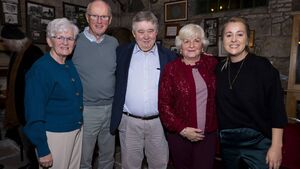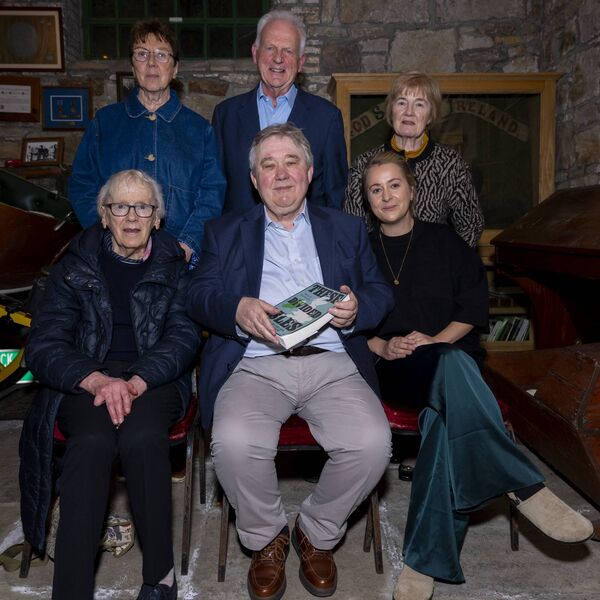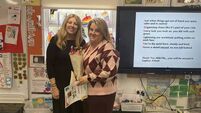Philip's story spans decades and borders

Pictured at the book launch were, from left: Evelyn and Anthony McNicholas, Philip Stephens, Beatrice Groarke and Jessica Stephens-Hemingway.
A full house at Kiltimagh Museum marked the Irish launch of , the new book by political commentator and author Philip Stephens.
The event brought together locals, friends, family, and visitors who gathered to hear the long-time journalist reflect on his personal and political ties to Ireland and to the Mayo town where he spent much of his childhood.
Monica Browne, of Kiltimagh Museum, welcomed the audience and introduced Tom Jordan, who officially launched the event. Tom spoke at length about the Stephens family's deep roots in the area, particularly in James Street, and recalled the close-knit relationships between the families who lived there.
“Philip described himself being more nervous here than talking to the House of Lords or the House of Commons,” Tom said, adding that this sense of home carried weight.
Tom spoke of Philip’s grandparents, who were next-door neighbours to the Jordans, and of the extended family’s strong links to the church and emigration. Philip’s mother Theresa had left Kiltimagh in 1949 to work in London, a move echoed by many of her generation.
Tom’s remarks painted a picture of mid-20th-century life in Kiltimagh, where local tradespeople like tailors and shoemakers formed the heart of the town, and where families like the Martins, connected to the Stephens family, were known for their intelligence and modesty.
“They were the most wonderful people,” Tom said. “They had two characteristics and you'll see it coming through in Philip tonight. They were highly intelligent people and they were humble people.”
He also recalled Philip’s visits to the town as a teenager, the friendships he made there, and even a youthful romance, lightly joking about someone “hiding down there, very embarrassed” in the audience.
Tom closed by describing as “easy to read, full of information, and delightful", suggesting that the book “should be on the Leaving Cert curriculum".
He added: “Every politician should read this book because it certainly has huge insight into Irish politics over the last 100 years.”

Philip began his own remarks by thanking all those involved in organising the evening, adding that he was especially moved by the warmth of the welcome he and his daughter Jess had received that day.
“I haven’t felt as nervous as giving this talk,” he said, despite decades spent addressing large audiences in professional settings.
He explained that although he had spent most of his life in London and had built a career writing about politics and international affairs, his roots in Mayo had shaped his sense of identity.
“Although I was born in London and I grew up in London, I’ve always regarded myself as Irish as well as British, and I have Kiltimagh to thank for that.”
Reading a passage from his book, Philip recalled the long summer journeys he and his brother made by train and ferry to reach Mayo, and the sense of wonder they felt arriving in a place so different from post-war London. He described a town where front doors were left unlocked, children roamed freely, and “the fog and the rain were part of the fun". For him, those summers “stirred a fascination with the relationship between Britain and Ireland” that would shape his later work.
Turning to the book’s themes, Philip said he wanted to explore the nature of this relationship, not just through the lens of history, but from both sides.
“It’s a relationship, most obviously one of enmity between the two nations,” he said, “but also one of curious intimacy.”
He traced this dual nature of the relationship back centuries, noting the British conquest and cruelty, but also the cultural and political entanglements that followed.
“You had the Anglo-Irish ascendancy, you had Irish soldiers in the British Army, and Irish political leaders campaigning for Home Rule within the British system.”
Philip said the book focuses on the 100 years since Partition. He argued that misunderstandings on both sides at the time helped create the conditions for the Troubles.
“I always assumed Partition was a final act of British petulance - they were being forced to leave Ireland, so they decided to keep a bit,” he said. “But in fact, the British wanted to leave entirely. Partition was a way out. They thought: once we’ve set up the unionists at Stormont, we can just forget about Ireland.”
Meanwhile, he said, the Irish government thought Partition would simply end when the British left.
“There was little effort made in the early decades to make the Republic appealing to those in the North. In some ways, it made the South less attractive,” he said.
Reflecting on the Good Friday Agreement, Philip said it was a rare example of “politics working”. He acknowledged that the agreement had brought peace but warned against assuming that demographics alone would lead to a united Ireland.
“It would be a mistake to just sit back and wait for it to happen,” he said.
He urged the Republic to begin a real discussion about what a united Ireland would look like and how it could include those in the North who see themselves as British.
“You can’t just bolt on the North and expect everyone to be happy,” he said. “It has to be a new partnership. It will produce a new and different Ireland.”
He referenced various political models and cited former Taoiseach Garret FitzGerald’s ideas on federalism.
“There are lots of possibilities,” he said. “But the conversation has to start.”
Philip concluded by quoting the Irish writer Hubert Butler, who had written in the 1950s about the Border either disappearing painlessly or remaining as a “definition which distinguishes but does not divide". Butler, he said, had understood that Ulster’s traditions added value to the island as a whole and should not be absorbed or erased.
“The wound is still there,” Philip said. “It’s healing. But we shouldn’t try to rip off the plaster before it’s fully healed.”
After the formalities, audience members mingled with the author and musicians, including a performance by harpist Mike Absalom, described by Tom Jordan as “one of the top folk musicians from the UK", and by Mick and Eilish from The Folk Café.
Copies of the book sold out on the night, with more available through local shops and online. The evening closed not with fanfare but with quiet conversations, warm greetings, and shared memories - the kind of connections that, like Philip’s story, span decades and borders.






